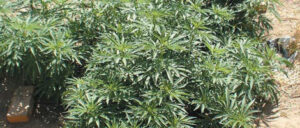
Dagga comes from the hemp plant Cannabis Sativa. It is normally green in colour and the head (flower) of the plant is smoked. It contains chemicals that affect the brain, heart, and lungs slowing down the Central Nervous System. Dagga comes in different forms that can be moist, dry or compressed.
The main active chemical in dagga is THC which is the most potent chemical in dagga. These chemicals stay in the body for weeks as they are stored in fat.
Also known as: Marijuana and Cannabis
Street names: Ganja, Pot, Weed, Herb, Boom, Dope, Spliff, Zol, Skyf, Grass
Dagga can also be categorised as an Hallucinogen.
How is it used?
Dagga can be smoked, swallowed or eaten. It is most commonly smoked in a hand rolled cigarette stuffed with dagga known as a ‘joint’ or ‘slowboat’. It can also be smoked in a pipe or mixed with Mandrax and smoked in a bottleneck known as a ‘white pipe’. Dagga is brewed and swallowed as tea or it is mixed in food and eaten in a muffin/cake known as ‘space cakes’/ ‘dagga cakes’.
Dagga is sold in plastic bank bags called ‘bankies’ or it is compressed into dagga parcels and bricks. If sold in a joint form they are known as zols, sticks or stops.
Dagga is also being manufactured in factories and greenhouses, kept indoors and controlled by heat to produce ‘home-grown’ hydroponics Dagga that creates a greater high. With this being done, the user can buy Dagga according to the type and strength they enjoy.
Symptoms of Dagga abuse:
- Bloodshot red eyes – the user may use eye drops to make their eyes appear ‘normal’.
- Increased sleep
- Mood changes
- Coughing
- Dry mouth
- Excessive use of deodorant to hide the smell of dagga
What are the effects of Dagga?
- Relaxation – feeling light-headed and giddy
- Euphoria – feelings of extreme happiness
- False confidence – the user will talk a lot and feel good about themselves.
- Increased Appetite – after using dagga the user will become hungry and will look for anything to eat. This is known as the ‘munchies’
- Decreased concentration
- Memory loss
- Impaired judgement – acting before thinking
- False reality – the user will see things differently and these experiences are not real e.g. seeing and hearing things that aren’t really there
What are the long-term effects?
- Addiction – dependence and cravings for dagga once the user has stopped. Not feeling able to cope without using.
- Decrease in concentration and memory leads to learning problems.
- Decreased motivation (little energy to carry out tasks) results in poor achievement in young users
- Impaired judgement and negative social behaviour. The user begins to rebel against authority figures e.g. parents, school/work and their risk-taking behaviour increases
- Decreases the immune system functioning. This works against the body’s ability to fight off infections and illness
- Damage to the organs, especially the brain, heart and lungs
- False reality and detachment can trigger a mental illness where the user will live in a semi-permanent state of confusion and loss of reality
- Depression
- Decrease in sexual health
This can involve:
- Decrease in sex drive. The user may lose interest in sex.
- Infertility in men and women (the inability to have children)
- Pregnancy: If the user is pregnant, continued dagga use will result in the baby suffering low birth weight, health problems and harm the baby’s muscle movement.
What happens when you STOP using?
Dependence and tolerance for dagga is built up gradually and it is clear that the user is addicted if they experience the following symptoms when stopping:
- Anxiety
- Irritability
- Depression
- Insomnia – problems sleeping
- Cravings – the physical and psychological need to have the drug
- Restlessness
